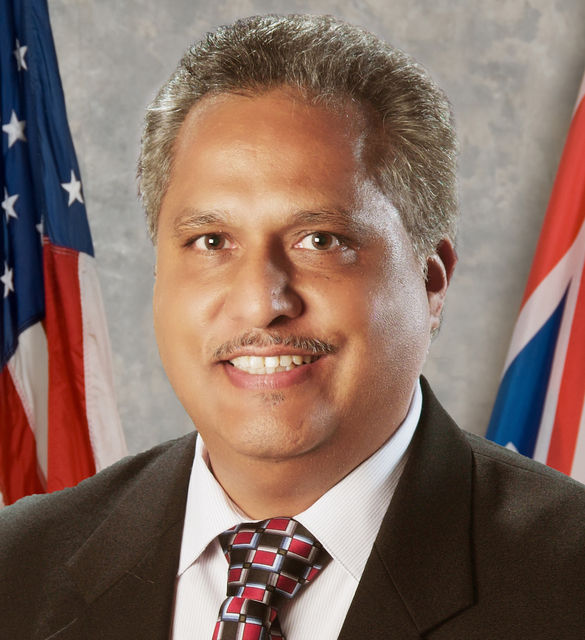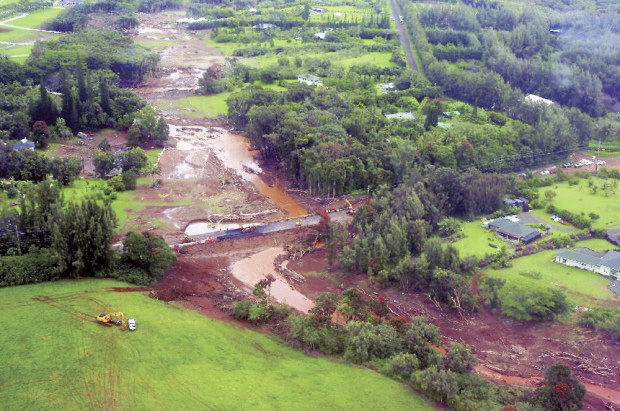Plantation-era ditches connecting dams on Kauai’s Eastside could flow again with $2.5 million worth of improvements under Gov. David Ige’s supplemental budget, bringing water to nearby Hawaiian Home Lands agricultural plots.
If approved by the Legislature, the capital improvement project will “imple- ment improvements to the deteriorated irrigation systems connecting the dams/reservoirs, in order to enable homestead agricultural production on Hawaiian home lands” in Anahola, said Department of Hawaiian Home Lands (DHHL) spokeswoman Paula Aila.
The $2.5 million request is part of $36.6 million in funding for capital improvement projects that DHHL will seek during the legislative session that opens later this month. The department is expected to make its first pitch for the Anahola project as part of an informational briefing before the state Senate’s Ways and Means committee on Jan. 14.
Access to water for farming has been a longstanding demand from current and prospective residents.
“DHHL Homesteaders have stated again and again that water for agriculture is a number one concern,” said KipuKai Kualii, a county councilmember and president of the Anahola Hawaiian Homes Association.
Accounting for plans to remove two of the five dams, the improved irrigation system would make as much as 326 acre-feet of water, or about 106.2 million gallons, available to DHHL’s agricultural homesteads. (An acre-foot is the amount of water it takes to cover one acre of land one foot deep).
That could be good news for the 46 homestead agriculture lessees who currently oversee property on the department’s Anahola lands.
But it may mean less for the roughly 2,100 applicants who are waiting to secure agricultural leases of their own on Kauai, including some who have been waiting for decades.
“Sadly, DHHL has not awarded any agricultural lots to native Hawaiian beneficiaries on the waitlist since 1984,” Kualii said.
The request is the latest attempt to secure state funding for repairs to the reservoirs and irrigation systems at Anahola, which “represent a liability to the DHHL, with the maybe potential for another (Ka Loko) type disaster,” the department wrote in its June 2010 regional plan for Anahola, referring to the 2006 dam break near Kilauea that claimed seven lives.
In 2014, DHHL lobbied the governor and the Legislature for a $6 million overhaul of the system.
After that request was denied, the department submitted a $3 million request during the 2015 legislative session to bring the reservoirs into compliance with the state’s Dam Safety Act. That money was approved but has not been dispensed.
Anticipating that money, Aila said DHHL plans to put renovations to the dams out to bid this spring. Meanwhile, if DHHL gets the $2.5 million it is asking for in 2016, it “will partially restore the original (capital improvement project) request of $6 million,” she said.
Statewide, many reservoirs face maintenance issues due to their age. Many were constructed a century ago by plantations in need of water and have fallen into disrepair in the decades after those businesses folded.
That means new owners face spending hundreds of thousands — or even millions — of dollars if they want to bring the dams and ditches back into service.
“For many of these plantation reservoirs, since their original source of financing (the plantation) is no longer available, finding alternate sources of adequate financing is difficult,” said Deborah Ward, spokeswoman for the Department of Land and Natural Resources (DLNR).
What’s more, 122 of Hawaii’s 138 dams have “high hazard potential” according to federal standards, meaning that “a dam or reservoir’s failure would result in possible loss of life,” Ward said.
That is a higher percentage than any other state, according to data from the Army Corps of Engineers.
Of the five dams currently at Anahola, the DLNR classifies three as having high risk potential.
The need for regular maintenance, coupled with the high costs, have led individuals and agencies responsible for reservoirs to turn to the state for financial assistance. State departments such as DHHL have submitted requests for capital improvement funding, while owners of dams on private land are able to apply to use state bonds to finance changes.
At Anahola, Lihue Plantation operated the reservoirs from their construction in 1920 until the plantation halted sugar cane cultivation in 1988. Since then, the reservoirs, along with the network of irrigation channels connecting them to agricultural land, have not had regular maintenance.
In its 2010 regional plan for the area, DHHL said it wanted to complete a study of the surface water resources in Anahola, including the dams. Uses floated for the reservoirs at the time included decommissioning, repurposing to meet local water needs and electricity generation through a hydroelectric system.
With the $3 million it has secured, the department plans to improve two dams — fields one and three of the Kealia Reservoir — and decommission two others: field two of Kealia and he Lower Anahola Reservoir.
While Kualii supports improvements to the irrigation system and existing dams, he was skeptical of efforts to take reservoirs offline permanently.
“It’s critical that we instead invest in the future irrigation of our agricultural lands by repairing and restoring what we have,” he said.






